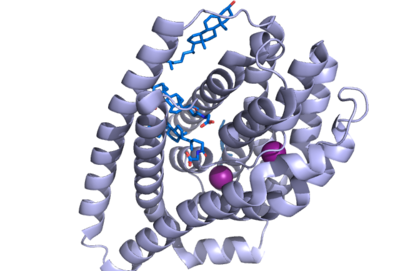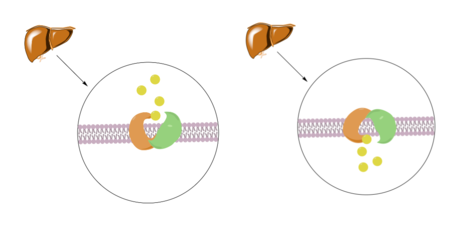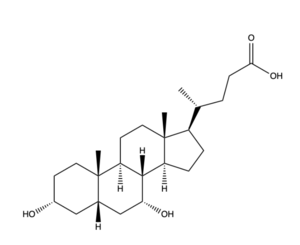Background

Figure 1. NTCP structure with both Na ions and bile salts bound. PDB file 7ZYI.
- Sodium taurocholate co-transporting polypeptide (NTCP) is a sodium-dependent transporter in the body that is responsible for the transportation of bile salts from the blood into epithelial liver cells. This carrier protein is responsible for a conformational change that allows bile salts to cross the cell membrane and enter the inside of liver cells. [1]. Both sodium ions and bile salts bind to NTCP in the same binding pocket on the molecule (Fig. 1). NTCP also acts as a receptor for Hepatitis B virus and Hepatitis D virus.
- The bile salts transported by NTCP are located within the gastrointestinal tract of the body and play a very key role in many biological functions. These functions include digesting and absorbing nutrients by helping break down fats and transporting lipid soluble nutrients into the liver. [2].
- The NTCP carrier protein itself can be found within hepatocytes, or the epithelial cells of the liver, but more specifically, within the basolateral membrane of these cells. [3]. The uptake of bile salts into the liver also allow for drugs to be both absorbed and excreted, as well as essential nutrients such as Vitamin A,D,E, and K to be absorbed in the small intestine.
Structural Overview
There are two significant areas in the NTCP structure that facilitate ligand binding, which are referred to as "patches." Residues 84-87 of NTCP are patch 1, which are located on the TM2-TM3 loop in the core domain. This is also considered the extracellular region of NTCP “tunnel." Residues 157-165 NTCP are associated with patch 2. They are located on N-terminal half of the TM5 in the panel domain (residue sequence: KGIVISLVL). Patch 2 is also located in th extracellular region. These residues' importance was determined through mutations of these residues and examined through pull-down assays (Asami, et. al, 2022).
Binding Pocket
- The NTCP binding pocket represents a "tunnel" lined with hydrophilic residues within the NTCP structure to allow hydrophilic bile salts and sodium ions to bind. When there are no bile salts bound to NTCP's binding tunnel, it forms a hollow hole in the middle of the structure, from . As bile salts bind to this binding pocket, the bile salts very nicely fill the hole within NTCP and fit almost perfectly within the tunnel, to the point where the can no longer be seen, as it is completely encompassing the bile salts.
Conformation Change
Mechanism

Figure 1. Bile Salt Uptake Mechanism.
The NTCP protein goes through a conformational change when assisting in the uptake of bile salt into the cell. This is accomplished through the opening of a wide transmembrane pore, creating a transport pathway for bile salts. The mechanism includes two sodium metal ions that allow for residue stabilization when going through the conformational change. Binding of the preS1 region of the HBV/HDV virus blocks any subsequent bile salt uptake. Thus, preS1 binding blocks the conformational change and entry of any salts into the cell. Residues 8-17 of preS1 are critical for NTCP:pres1 binding. Patch 1 and Patch 2 (external) residues interact with residues 8-17 of preS1 to facilitate binding.
Significance
NTCP serves a multitude of biological functions, including bile salt uptake and HBV/HDV binding. NTCP is a key player in the absorption and digestion of fats and fat-soluble vitamins in the body, as well as the synthesis of bile within the liver. The uptake of bile salts, transcriptional and post-transcriptional, are signaling molecules for the liver and intestine.
Bile Salt Uptake

Figure 2. Bile Salt Structure.
Disease of the liver is due to a decrease in bile salt uptake. This disease is transferred through bodily fluids between organisms. Liver Disease causes symptoms such as jaundice, abdominal pain and swelling, and swelling of the legs and feet. Liver disease can lead to liver cancer and other life-threatening diseases, making bile salt uptake essential to liver function.
HBV/HDV



